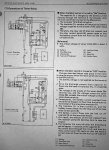Hi,
I have an L3010 GST that went dead on me. At the beginning of this problem, the dash warning lights would come on when I turned on the key but when I turned the key to start, I just heard a clunk (from the solenoid I presume) and then the lights would go out. If I tried again, I would get no lights or anything. If I let it set for a little while, I would get the dash lights again and the clunk one time and then nothing again. Over the next several days as I tried to diagnose the problem, the lights gradually quit coming on at all when I would try the key. Now I've got nothing--it is now 3 weeks later.
I thought it was a bad ground or battery. I had the battery checked at NAPA--it's good. I replaced the ground from the battery to the frame (after wire brushing the frame so it was shiny). Using a multimeter, I have fire from the battery to the starter. I have continuity on both the PTO and neutral safety switches.
After doing more tracing with the multimeter and reading some old posts on this forum, I replaced the starter relay and the ignition switch. Still nothing.
After replacing the relay and switch, the multimeter shows I have fire on the plugin to the relay (where the red wire comes in), but nothing on the other terminals when I turn the key. I pulled the plugin to the starter solenoid and checked it with the meter--no fire when I turn the key.
It seem like the circuit is broken somewhere. Maybe the glow relay? I am running out of ideas. Any thoughts?
Thanks
I have an L3010 GST that went dead on me. At the beginning of this problem, the dash warning lights would come on when I turned on the key but when I turned the key to start, I just heard a clunk (from the solenoid I presume) and then the lights would go out. If I tried again, I would get no lights or anything. If I let it set for a little while, I would get the dash lights again and the clunk one time and then nothing again. Over the next several days as I tried to diagnose the problem, the lights gradually quit coming on at all when I would try the key. Now I've got nothing--it is now 3 weeks later.
I thought it was a bad ground or battery. I had the battery checked at NAPA--it's good. I replaced the ground from the battery to the frame (after wire brushing the frame so it was shiny). Using a multimeter, I have fire from the battery to the starter. I have continuity on both the PTO and neutral safety switches.
After doing more tracing with the multimeter and reading some old posts on this forum, I replaced the starter relay and the ignition switch. Still nothing.
After replacing the relay and switch, the multimeter shows I have fire on the plugin to the relay (where the red wire comes in), but nothing on the other terminals when I turn the key. I pulled the plugin to the starter solenoid and checked it with the meter--no fire when I turn the key.
It seem like the circuit is broken somewhere. Maybe the glow relay? I am running out of ideas. Any thoughts?
Thanks


